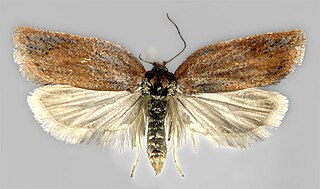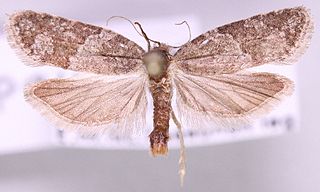
Acleris forsskaleana, the maple leaftier moth, is a moth of the family Tortricidae. It is found in Europe and North America in woodlands and gardens.

Acleris sparsana is a moth of the family Tortricidae found in Europe and Iran. It was first described in 1775 by the Austrian lepidopterists Michael Denis and Ignaz Schiffermüller.

Acleris comariana, the strawberry tortrix, is a moth of the family Tortricidae. It is found in Europe, the Caucasus, Amur, Kamchatka, China, Korea and Japan.

Acleris rhombana, the rhomboid tortrix, is a moth of the family Tortricidae. It is found in the Palearctic realm, from Europe to the Caucasus, Armenia, and Turkmenistan.

Acleris hyemana is a moth of the family Tortricidae. It is found in Europe.

Epinotia nanana, the European spruce needleminer, is a moth of the family Tortricidae. It is found from northern and central Europe to Russia and Mongolia.

Gypsonoma aceriana, the poplar shoot-borer, is a moth of the family Tortricidae. It is found from Europe to Russia, eastern Turkey and Iraq. It is also present in North Africa.

Acleris hastiana is a moth of the family Tortricidae. It is found in Europe, northern Iran, Kazakhstan, Ala Tau, central Siberia, Irkutsk, the Amur region and China. In North America it is found from the north-eastern United States across southern Canada to British Columbia and south along the Pacific Coast to California.

Acleris rufana is a moth of the family Tortricidae. It is found from northern, central and south-western Europe through southern Siberia to the Russian Far East and Japan.

Acleris cristana, the rufous-margined button moth, is a moth of the family Tortricidae and is found from Europe through the Caucasus and Ussuri to Japan.

Acleris holmiana, the golden leafroller moth, is a moth of the family Tortricidae. It is found in most of Europe and Asia Minor.

Acleris laterana is a moth of the family Tortricidae. It is native to the Palearctic realm, but has been accidentally imported into the United States.

Acleris ferrugana is a species of moth of the family Tortricidae. It is found in China, most of Europe and has also been recorded from North America.

Cochylis dubitana, the little conch, is a moth of the family Tortricidae. It is found in China (Heilongjiang) and most of Europe. and the Caucasus. It is also found in North America, where it has been recorded from Colorado, Maine, Ontario and Washington.

Acleris bergmanniana, the yellow rose button moth, is a moth of the family Tortricidae. It is found from most of Europe to the eastern Palearctic realm.

Acleris schalleriana, the viburnum button or Schaller's acleris moth, is a moth of the family Tortricidae. It was described by Carl Linnaeus in 1761. It is found in most of Europe. It is also found in North America. Acleris viburnana is a possible synonym that refers to the North American populations.

Cnephasia pasiuana, the meadow shade, is a moth of the family Tortricidae. It was described by Jacob Hübner in 1799. It is found in almost all of Europe. The habitat consists of rough pastures, fens and marshy areas.

Notocelia incarnatana, the chalk rose bell, is a species of moth of the family Tortricidae. It is found in China, Mongolia, Japan, Russia, Kazakhstan and Europe, where it has been recorded from most of the continent, except parts of the Balkan Peninsula.

Acleris abietana, the Perth button, is a species of moth of the family Tortricidae. It is found in Europe, where it has been recorded from Great Britain, Ireland, France, Belgium, the Netherlands, Germany, Denmark, Austria, Switzerland, Italy, the Czech Republic, Slovakia, Slovenia, Poland, Hungary and Russia. The habitat consists of coniferous woodlands.

Epinotia abbreviana is a moth of the family Tortricidae. It is found in Europe and was first described by Johan Christian Fabricius in 1794.






















